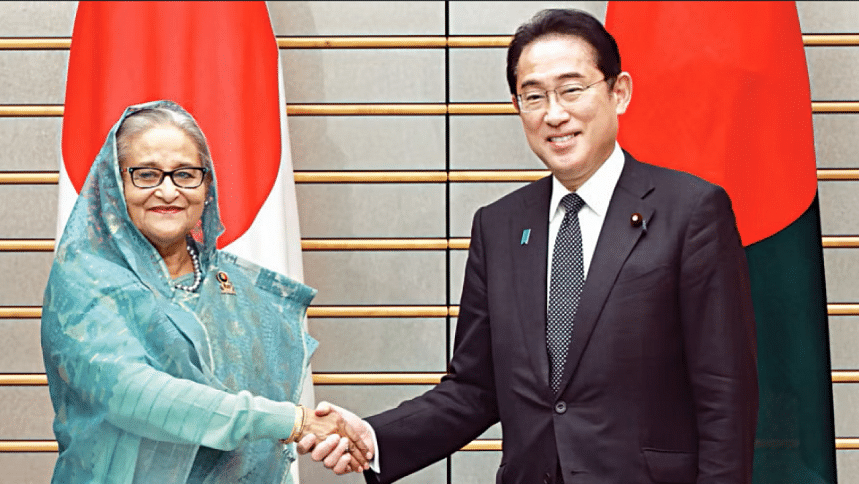Last update on: Mon May 22, 2023 08:00 AM

Over the last five decades, the relationship between Bangladesh and Japan has flourished and evolved into a mutually beneficial and symbiotic partnership, bringing about positive outcomes for both countries.
The bilateral relationship has undergone significant growth – trade and investment have emerged as crucial factors contributing to this progress. Japan has established itself as one of Bangladesh’s primary trading partners, alongside the US and the European Union (EU). Over the years, Bangladesh’s exports of apparels and ready-made garment (RMG) products to Japan have experienced a steady rise, currently constituting approximately 83 percent of the country’s total exports to Japan. Furthermore, the export of footwear and leather products to Japan holds notable significance, although it only accounts for 2.4 percent of the total exports to the East Asian country. Notably, the export of leather products has exhibited consistent growth, reaching its highest share of 4.1 percent in FY2020-21. Bangladesh’s export of fisheries to Japan has been gradually increasing, too, albeit at a slow pace.
Bangladesh has also experienced a notable increase in its imports from Japan. Japan serves as a significant source for various raw materials, including steel and iron. In 2020, the highest imports from Japan to Bangladesh consisted primarily of iron and steel, followed by Japanese vehicles, vehicle parts and accessories, and manmade staple fibres.
Despite all this, there remains untapped trade potential on both sides. The actual export value of certain items falls below their potential export value, indicating an opportunity for Bangladesh to expand the supply of these items to the Japanese markets. Notably, there are significantly unexplored export avenues such as knitwear, textile, shrimps, and frozen goods. Likewise, Japan can also expand its range of export products for Bangladesh, including diesel-powered trucks, compression-ignition internal engines, waste and scrap iron and steel, and other machinery items.
The bilateral trade between the two countries increased because of the Comprehensive Economic Partnership launched in 2014. Japan has granted Bangladesh the General System of Preference (GSP) facility, which allows lower tariffs compared to the general rates. Additionally, as a least developed country (LDC) at the moment, Bangladesh benefits from special preferential tariffs, allowing duty-free and quota-free (DFQF) market access to Japan for 97.9 percent of its exported products, excluding fishery products, rice, sugar, and articles of leather. The implementation of a free trade agreement (FTA) between Bangladesh and Japan would create investment opportunities and enhance market access for both nations. Without a bilateral trade agreement, when Bangladesh graduates to the developing country category in a few years, it will lose the preferential tariffs for its export goods. According to estimates based on data from the International Trade Centre, manufactured goods, particularly textiles and RMG items, would be imposed with higher tariffs, ranging from approximately 7.4 percent to 12.8 percent, after Bangladesh’s LDC graduation.
In order to have a fruitful collaboration, Bangladesh must focus on diversifying its economy, enhancing the skills of its workforce, and improving production efficiency.
Trade in services also presents significant opportunities for these two countries. A notable opportunity lies in Japan’s growing demand for caregivers, driven by its ageing population and increased life expectancy. Bangladesh has a sizable young workforce; capitalising on this demographic advantage, young people from Bangladesh can find employment in Japan’s healthcare sector. To facilitate this mutually beneficial arrangement, collaborative partnerships between both the governments and private sectors can establish training programmes to this end. By seizing the opportunity to send caregivers to Japan, Bangladesh stands to gain through remittance and the enhancement of interconnected relationship between the two nations. Simultaneously, Japan would greatly benefit as its expanding elderly population receives the invaluable support and compassionate care provided by these caregivers.
The Japanese foreign direct investment (FDI) in Bangladesh commenced in the mid-1970s and gained momentum during the early 1990s with the implementation of liberalisation policies in Bangladesh. Though the Japanese FDI in Bangladesh has experienced fluctuations, it increased in 2022, when Bangladesh received the highest influx of FDI from Japan, totalling a little over $120 million. Currently, approximately 300 Japanese companies are operating within Bangladesh. Recognising the significance of Japanese investment, the government has designated places in Araihazar, Narayanganj to establish the Japanese Economic Zone (JEZ). Spanning 1,000 acres initially, the JEZ holds the potential for future expansion. The completion of the JEZ is expected in 2034, with operations commencing in the same year.
Companies operating within the economic zones of Bangladesh, including the JEZ, will enjoy various benefits such as tax exemptions, 50 percent income tax immunity on export earnings, duty-free exports, cash incentives, facilities for bonded warehouses, and duty drawbacks. Additionally, the JEZ in Narayanganj will offer basic healthcare facilities for companies located within its premises. Projections indicate that by 2034, the JEZ will reach the maximum occupancy of industrial space, accommodating over 120 industrial units. These industrial units are expected to create more than 60,000 job opportunities. This development is likely to attract more Japanese investments, ultimately bolstering the bilateral trade.
In order to have a fruitful collaboration, Bangladesh must focus on diversifying its economy, enhancing the skills of its workforce, and improving production efficiency. To ensure greater efficiency and competitiveness, we should expedite the adoption and adaptation of technology. In facilitating a seamless transition towards a developing country, Japan has the potential to collaborate with Bangladesh by increasing investments in technology, physical and soft infrastructure, and fostering improved trade and financial integration. Japan is expected to remain a crucial and strategic partner for Bangladesh throughout its upcoming developmental journey, particularly during the Fourth Industrial Revolution and beyond LDC graduation.
As the largest bilateral development partner of Bangladesh, Japan has been a dedicated collaborator, working closely with the nation in numerous initiatives. Their joint efforts have been focused on infrastructure development, fostering industrialisation, improving access to healthcare and education, and addressing vulnerabilities. The long-standing friendship between Bangladesh and Japan provides a strong foundation for propelling their partnership forward into the next phase. By leveraging the substantial demographic, investment, trade, and technological complementarities between the two countries, this partnership can create a mutually advantageous alliance for their shared journey of progress.
Dr Fahmida Khatun is executive director at the Centre for Policy Dialogue (CPD). Views expressed in this article are the author’s own.









